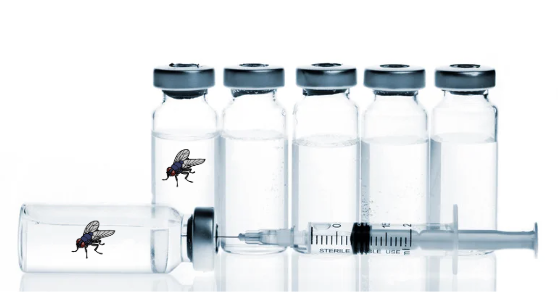Galenisys Newsletter : April 2025

Table of Contents
By Tony Dunford
Editor
-
THE TOUGHEST EPIDEMIC EVER AT US CENTERS OF DISEASE CONTROL?
By the Editor -
ESTABLISHING AFRICAN VACCINE MANUFACTURING Part 1
By Richard van Duyse -
THE PROJECT MANAGERS NOTEBOOK part 9
By “Aubonne” -
NON CONFORMATIES: LIFE SCIENCES CONTINUING PROBLEM
The second in a new series of articles on complex areas of QA, tools & techniques.
Steve Biddulph
THE TOUGHEST EPIDEMIC EVER AT US CENTERS OF DISEASE CONTROL?
By the Editor
As readers probably know the Centers for Disease Control and Prevention, or CDC, is America's most important public health agency. We often mention its findings in our Newsletters.
It is tasked with keeping America safe. It’s top recent priorities (until February) were following in real time the measles outbreak (that killed a second American in March), and the bird flu epidemic now ravaging flocks in every state, - see our previous editions. The staff checks on overseas outbreaks in order to prevent impact on the USA, managing the reserves of relevant medicine & vaccines.
The CDC is now faced by new diseases they've never seen before. As a result, its experienced & well-educated staff are reacting in fear & and confusion.
It’s because these diseases are spread WITHIN THE AGENCY ITSELF!!
They are certainly spread in part by strangers - some in jeans & Tesla tee shirts - who have evaded the Centre’s immunity system - the “military grade security measures” which normally allows entry to authorised visitors and staff only.
Numerous verified reports say one result is that new contaminated genetic code has been introduced into the staffs’ computers as a result.

The acronym DOGE (The Degrading of Generalised Education) is useful to describe this new group of diseases, often spread online, and their effects. (Associated & uncontrolled outbreaks have been reported at the US Department of Education, & USAID).
One example is the emails which arrived on the infected CDC computers which stated that CDC staff are banned from communicating with the public without explicit approval from the “OPM” (one of the first organisations to be infected!).
Publications such as “The Morbidity & Mortality Report” (surely essential prior to & during epidemics) issued weekly by the Centre for 60 years suddenly stopped. Communication with other agencies as well as the general public also ceased.
Researchers have frantically pulled back submitted journal papers & stopped collecting data. CDC funds normally dispersed to aid State & local Health Authorities stopped, without explanation or alternative financial treatment.
Given the Centers job of protecting the health of Americans some resistant staff - loyal to their mandate - have developed alternative remedies to the infected computers, in order to continue their work, by using Signal for encrypted chatting, or closing down their infected computers to prevent work being monitored by “malign actors”. Others put their phones on aeroplane mode when they’re not working.
However, in an echo of how viruses mutate & continue to damage patients, the DOGE diseases have evolved by borrowing a measure normally advised by the CDC only in extreme circumstances: MASS CULLING!
In the past this was used to prevent an epidemic spreading from e.g. infected flocks of farmed birds, or cattle herds. Now DOGE epidemic is causing the culling of CDC staff!
In an echo of gangsters operating outside the law, on St Valentines Day 750 staff were fired (by email of course).
Such staff, and their colleagues suffer the recognised symptoms of fear, confusion, & paranoia. This can lead to patient paralysis.
Optimistic employees put their faith in preventative remedies prescribed by the Courts, but these can be slow in acting. Perhaps natural immunity to DOGE & the malign actors, will develop within the American general public……. to protect their own protectors.
The Editor
ESTABLISHING AFRICAN VACCINE MANUFACTURING Part 1

By Richard van Duyse
Experienced international vaccine industry consultant. Specialized in project & operational management, facility design, start-ups, & technology transfers. Bachelor of Applied Science (B.Sc.).

Local or regional production of vaccines in Africa could reduce dependency on global supply chains, improve access to these essential products, and strengthen resilience against future health crises.
However, this requires that to succeed, certain conditions have to be met. These conditions include a variety of "Political, Economic Social & Technical (PEST)" factors including infrastructure and finance. I’ll consider 4 of these key conditions below:
1 Technological access and innovation
-
Technology transfer: African countries should have access to modern production technologies such as mRNA and other technology platforms through partnerships or licensing agreements. The right agreements (QTA, TT) must be in place. Backwards implementation of the vaccine value chain should be seriously considered.
-
R&D capacity: Investing in local research institutes and developing associated technologies will build experience & the local expertise pool.
2 Infrastructure and production facilities
-
New production centers must comply with international quality standards such as GMP (Good Manufacturing Practices), for patient & Government credibility.
-
Cold Chain Storage & Distribution Systems are essential to safely store and distribute vaccines, especially to remote areas.
-
Regional hubs in strategic regions of Africa are necessary to achieve economies of scale & fast distribution.
-
Facilities should be designed to cater for the manufacturing of a variety of vaccines, and to ramp up production in the event of a pandemic or high demand.
3 Financing and investments
-
Firm funding pledges from Governments and international organizations to invest in vaccine company startup costs; is an essential pre-requisite.
-
Public-private partnerships & collaboration have been shown to be successful in financing the industry.
-
Partner finance from WHO, GAVI, African Development Bank, Country Governments, and foundations such as the Gates Foundation, need to continue.
-
Establishing viable vaccine infrastructure requires a long-term commitment to funding.
4 Regulatory Compliance & Quality Assurance.
-
Clearly African countries need to develop – regionally & locally - robust and well-functioning regulatory authorities to ensure the quality, safety and effectiveness of vaccines. Responsibilities will include ethics and clinical trials, permits and certifications, registration of and release of vaccines and post marketing surveillance.
-
Harmonization of regulations and guidelines (GMP, WHO, FDA, EMA etc) between countries within the African Union or regional economic blocs is essential for standardization & accelerated approvals.
-
QC Laboratories for the analysis of starting materials, components, intermediate products and final products, as well as validation, are required.
-
Similarly, QMS and IT systems to monitor and control of processes, documents, training, etc, are a necessity.
It can already be seen that building up of a vaccine manufacturing facility is a complex process and with unique risks, different from a pharmaceutical project. Besides the huge funding challenges, the timescales to build up a functioning facility are longer and are impacted by local conditions.
In Part 2 of “Establishing African Vaccine Manufacturing” in our May newsletter, I'll deal with Political and Government support, Market Development, Human Capital, Sustainability, and Collaboration and Partnerships.
Richard van Duyse
References:
Kristopher Howard: “Risk 2: Can you really build a vaccine manufacturing facility in 14-16 months?”
The Galenisys team of Arabic, English, & French members have already worked on more than a dozen pharma projects for WHO, Government, or private companies in Africa.
The Editor
THE PROJECT MANAGERS NOTEBOOK part 9
The project wrap up and hand over – Technical Aspects.
By “Aubonne”
In this and next month's article we’ll look at the final stages in a pharma project – this month the technical side, & next month the financial.
At this stage of the Project, the Project Manager is looking for the final phase signed off deliverables to appear, and that everything will be nicely tidied up. These deliverables will no doubt include the following:
-
"The “As built” drawings"
-
The maintenance manuals or instructions.
-
The conclusion of training sessions.
-
The spare parts lists.
-
The service contract proposals and “call out” arrangements
-
The approved Performance Qualification Reports.

All these late-stage deliverables should have been included in the scope of relevant work packages (and any approved Variations to them).
The approval of these deliverables will likely involve a number of people. Typically, the engineers who scoped the packages, the Head QA Qualification. The production / QC managers who will run particular units / departments & receive the equipment will be keen to see that their new domains are complete.
And in particular the maintenance team who will be responsible for keeping things running action after handover will certainly need the items indicated*.
However, there will be some team members or contractors who are tired, homesick, or both. There may well be key people (needed for completions or sign offs) who are involved in other projects in the exciting armchair phase at the beginning where there's plenty of meetings, and less pressure.
On site contractors will be anxious to get personnel, their kit, and portacabins, cranes, etc off site. It's time to ensure completion of the “little things” such as “the totems”, safety signage, pipeline ID tags /labels, painting the white lines on the access road, or planting the vegetation, and other items on the “snags list”.
So, a vital part of the project manager's job is to ensure that people remain available. For contractors, subcontractors, of course, his main tool is their final invoice payment. But he also needs to ensure that his own team numbers, & the departmental heads (or nominated deputies) receiving the facilities are available for their vital roles, if necessary, by reference to the client / project sponsor.
At this time, some errors or omissions may come to light, causing tough choices to be made. An example I encountered concerns an autoclave, purchased to the engineer’s scope, from an Italian supplier. The scope included a particular certified grade of stainless steel for the chamber. The certificate should have appeared with the autoclave when it arrived on site, & before interim payment. The certificate was frequently promised but never delivered.
This “non-conformity” was highlighted in the qualification report, by the time the autoclave was well embedded in the completed area. Clearly non-acceptance would jeopardise project completion date. In the end, the project had to take the omission on the chin. All because of a lax sign off at the correct stage.
“Aubonne”
NON CONFORMITIES: LIFE SCIENCES CONTINUING PROBLEM

by Steve Biddulph
Fellow of Royal Society of Biology. Board level pharma experience. QSM and Aseptic Manufacturing & Control Expertise. Galenisys Managing Director.
The 3rd of a series on tackling recurrent issues faced by Quality Assurance
A non-conformity is any event or result arising during the manufacture, testing or distribution of a product that deviates from established procedures, processes, specifications or normal values. It is important to grasp the significance of this wide definition, as it implies that these issues can originate or occur at any time during product, during research, development or ongoing manufacture and distribution.
A non-conformity demonstrates a failure in the integrity of the Quality System and could include non-compliance with relevant "Good Manufacturing Practices (GMPs)" and other regulatory requirements. It could indicate that a product may not comply with its required quality attributes.
“Non-conformities are all events that do not meet expected values or do not follow established procedures or validated processes. I.e. a deviation from normal practice or out-of-trend, out of specification or out of limit results, complaints, ADEs, adulterated documentation, or, quite simply, any unexpected events such as in:
-
the purchase, receipt and testing of materials
-
the manufacture, packaging and testing of starting materials & APIs, components, API), intermediates and finished products.
-
the warehousing, handling and distribution of all the above items.
-
the maintenance, calibration, cleaning and operation of facilities, equipment and utilities.
-
Use of IT systems
-
Monitoring of physical, microbiological and non-viable contamination
-
Project protocols and reports
-
Qualification and Validation
-
QC test methods and results
-
Training of employees
-
Any activity that may have direct or indirect impact on the above items; or on Regulatory requirements or those of the company’s Quality System
Any unexpected event must be taken seriously and investigated

The sequence of necessary action on non-conformities is
- Logging all non-conformities
- Investigation of each
- Assessment of impact on product quality, compliance with relevant regulatory requirements (GMPs, etc).
- Proof of no adverse impact before market release of implicated batch(es)
- Corrective and Preventative Actions (CAPA) implementation to prevent recurrence.
- Formal check of resulting CAPAs for short term & long term effectiveness.
Galenisys has standard documentation for non-conformity identification, investigation and correction. If you are having difficulty with this area of your operation, then contact us.





